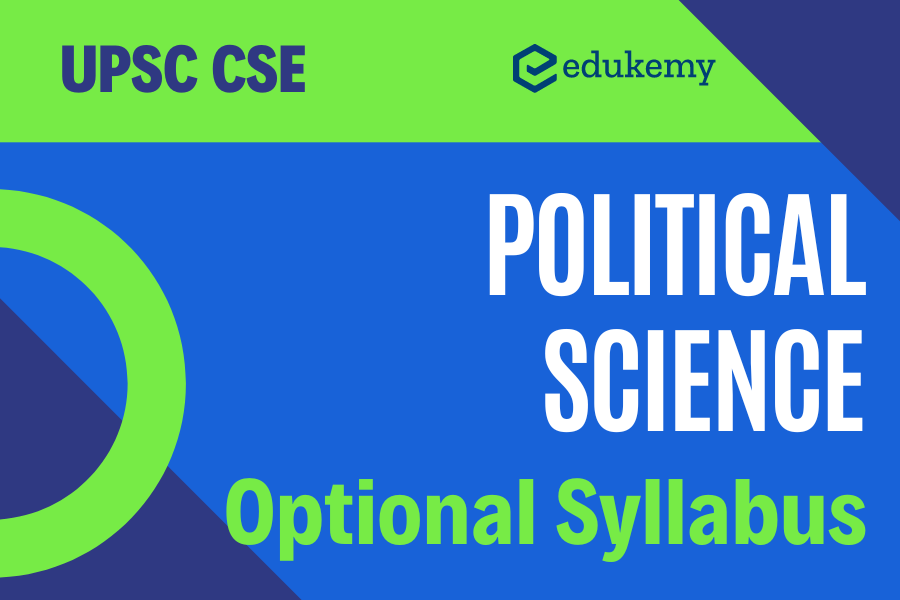
The UPSC includes Political Science as one of the optional subjects among the 48 subjects available for candidates to choose from. The syllabus for Political Science in the UPSC exam is highly specialized and covers a wide array of topics, including political theory, comparative politics, international relations, public administration, and Indian politics.
Candidates who choose Political Science as their optional subject will have to appear for two papers, with each paper carrying 250 marks, resulting in a total of 500 marks for this subject. These optional papers play a significant role in the UPSC Mains Examination, which follows the IAS Preliminary exam. Although Political Science may not be as popular as some other subjects for the IAS Mains exam, individuals with a graduation degree or a strong background in Political Science have the opportunity to select it as their preferred optional subject.
Contents
- 1 Political Science Optional Syllabus: Paper-1
- 2 Political Science Optional Syllabus: Paper-2
- 3 Frequently Asked Questions (FAQs)
Political Science Optional Syllabus: Paper-1
Section A: Political Theory and Indian Politics
- Political theory: meaning and approaches.
- Theories of the state: Liberal, Neo-liberal, Marxist, Pluralist, Post-colonial, and feminist.
- Justice: Conceptions of justice with special reference to Rawl’s theory of justice and its communitarian critiques.
- Equality: Social, political, and economic; the relationship between equality and freedom; Affirmative action.
- Rights: Meaning and theories; different kinds of rights; the concept of Human Rights.
- Democracy: Classical and contemporary theories; different models of democracy-representative, participatory, and deliberative.
- Concept of power: hegemony, ideology, and legitimacy.
- Political Ideologies: Liberalism, Socialism, Marxism, Fascism, Gandhism and Feminism.
- Indian Political Thought: Dharmashastra, Arthashastra, and Buddhist traditions; Sir Syed Ahmed Khan, Sri Aurobindo, M.K. Gandhi, B.R. Ambedkar, M.N. Roy.
- Western Political Thought: Plato, Aristotle, Machiavelli, Hobbes, Locke, John S. Mill, Marx, Gramsci, Hannah Arend
Section B: Indian Government and Politics
- Indian Nationalism:
- Political Strategies of India’s Freedom Struggle: constitutionalism to Mass Satyagraha, Non-cooperation, Civil Disobedience; militant and revolutionary movements, Peasant and workers’ movements.
- Perspectives on Indian National Movement: Liberal, Socialist and Marxist; Radical humanist and Dalit.
- Making of the Indian Constitution: Legacies of the British rule; different social and political perspectives.
- Salient Features of the Indian Constitution: The Preamble, Fundamental Rights and Duties, Directive Principles; Parliamentary System and Amendment Procedures; Judicial Review, and Basic Structure doctrine.
- a. Principal Organs of the Union Government: Envisaged role and actual working of the Executive, Legislature, and Supreme Court.
- b. Principal Organs of the State Government: Envisaged role and actual working of the Executive, Legislature, and High Courts.
- Grassroots Democracy: Panchayati Raj and Municipal Government; the significance of 73rd and 74th Amendments; Grassroots movements.
- Statutory Institutions/Commissions: Election Commission, Comptroller and Auditor General, Finance Commission, Union Public Service Commission, National Commission for Scheduled Castes, National Commission for Scheduled Tribes, National Commission for Women; National Human Rights Commission, National Commission for Minorities, National Backward Classes Commission.
- Federalism: Constitutional provisions; changing nature of center-state relations; integrationist tendencies and regional aspirations; inter-state disputes.
- Planning and Economic Development: Nehruvian and Gandhian perspectives; the role of planning and public sector; Green Revolution, land reforms and agrarian relations; liberalization and economic reforms.
- Caste, Religion and Ethnicity in Indian Politics.
- Party System: National and regional political parties, ideological and social bases of parties; patterns of coalition politics; Pressure groups, trends in electoral behavior; changing socio-economic profile of Legislators.
- Social Movements: Civil liberties and human rights movements; women’s movements; environmentalist movements

Political Science Optional Syllabus: Paper-2
Section A: Comparative Political Analysis and International Politics
- Comparative Politics: Nature and major approaches; political economy and political sociology perspectives; limitations of the comparative method.
- State in comparative perspective: Characteristics and changing nature of the State in capitalist and socialist economies, and, advanced industrial and developing societies.
- Politics of Representation and Participation: Political parties, pressure groups, and social movements in advanced industrial and developing societies.
- Globalization: Responses from developed and developing societies.
- Approaches to the Study of International Relations: Idealist, Realist, Marxist, Functionalist and Systems theory.
- Key concepts in International Relations: National interest, Security and power; Balance of power and deterrence; Transnational actors and collective security; World capitalist economy, and globalization.
- Changing International Political Order:
- (a) Rise of superpowers; strategic and ideological Bipolarity, arms race and Cold War; nuclear threat;
- (b) Non-aligned movement: Aims and achievements;
- (c) Collapse of the Soviet Union; Unipolarity and American hegemony; relevance of non-alignment in the contemporary world.
- Evolution of the International Economic System: From Bretton Woods to WTO; Socialist economies and the CMEA (Council for Mutual Economic Assistance); Third World demand for new international economic order; Globalisation of the world economy.
- United Nations: Envisaged role and actual record; specialized UN agencies-aims and functioning; the need for UN reforms.
- Regionalization of World Politics: EU, ASEAN, APEC, SAARC, NAFTA.
- Contemporary Global Concerns: Democracy, human rights, environment, gender justice, terrorism, nuclear proliferation.
Section B: India and the World
- Indian Foreign Policy: Determinants of foreign policy; institutions of policy-making; continuity and change.
- India’s Contribution to the Non-Alignment Movement: Different phases; current role.
- India and South Asia:
- Regional Co-operation: SAARC-past performance and prospects.
- South Asia as a Free Trade Area.
- India’s “Look East” policy.
- Impediments to regional co-operation: river water disputes; illegal cross-border migration; ethnic conflicts and insurgencies; border disputes.
- India and the Global South: Relations with Africa and Latin America; leadership role in the demand for NIEO and WTO negotiations.
- India and the Global Centres of Power: USA, EU, Japan, China and Russia.
- India and the UN System: Role in UN Peace-keeping; Demand for Permanent Seat in the Security Council.
- India and the Nuclear Question: Changing perceptions and policy.
- Recent developments in Indian Foreign policy: India’s position on the recent crisis in Afghanistan, Iraq, and West Asia, growing relations with the US and Israel; and the vision of a new world order.
Frequently Asked Questions (FAQs)
1. Question: What are the key themes covered in the political science optional syllabus?
Answer: The political science optional syllabus typically encompasses a range of themes, including political theory, comparative politics, international relations, and Indian politics. Key topics may include political ideologies, state institutions, governance, political behavior, and global geopolitical issues. It often aims to provide a comprehensive understanding of political structures, processes, and theories.
2. Question: How can one effectively prepare for the political science optional paper?
Answer: Effective preparation for the political science optional paper involves a combination of in-depth reading, critical analysis, and practice. Candidates should thoroughly study core political science texts, stay updated on contemporary political developments, and engage in regular answer writing practice. Understanding the nuances of political theories and their application to real-world scenarios is crucial. Additionally, candidates should be well-versed in relevant case studies and examples to enrich their answers.
3. Question: Is it necessary to specialize in a particular area within political science for the optional paper?
Answer: While it’s not mandatory to specialize in a specific area, having a focus or specialization can enhance the depth of one’s understanding. Candidates can choose to specialize in areas such as political philosophy, international relations, comparative politics, or Indian politics based on their interests and strengths. However, a well-rounded knowledge of the broader political science syllabus is essential, and candidates should be able to connect different topics to provide a comprehensive and nuanced perspective in their answers.
In case you still have your doubts, contact us on 9811333901.
For UPSC Prelims Resources, Click here
For Daily Updates and Study Material:
Join our Telegram Channel – Edukemy for IAS
- 1. Learn through Videos – here
- 2. Be Exam Ready by Practicing Daily MCQs – here
- 3. Daily Newsletter – Get all your Current Affairs Covered – here
- 4. Mains Answer Writing Practice – here
Visit our YouTube Channel – here

